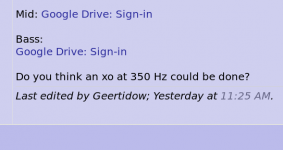Probably overshoots for this thread but at least tell how measurements and processing should be done if anechoic or large space is not available and project targets are high including off-axis, power and directivity responses.
Quick manual to produce measurement data with REW
Quick manual to produce measurement data with ARTA
Quick manual to produce measurement data with REW
Quick manual to produce measurement data with ARTA
We shouldn't make this more complicated than it is. If one studies waveforms that have had various filters applied, and sees how phase can go, for example, even beyond 360 degrees (and what that looks like) I think you'll find that the two are not that different.
Hi Allen, with all due respect to the knowledge and generous advice you give to the forums, it is important to recognize that time and phase are quite different.
And that neither is a substitute for correcting the other; for example group delay cannot simply be offset with a fixed time delay at xover frequency.
I'd suggest Bob McCarthy's https://www.amazon.com/Sound-System......... (and is an awesome general reference.)
After a day of hard work, using the methods described above, I ended up with 139 us delay on the tweeter and 21 us delay on the mid (@ 1.5 m distance).
Measuring outside I ended up with a crossover (LR 4th order) at 700 Hz (WM) and 3500 Hz (MT). This xo produced consistent results with on- and off axis measurements about 2 m away outside.
On axis:
Off axis (horizontal):
Off axis (vertical at woofer level):
javascript:;
I am pleased with the results so far, and I don't know exactly if further improvement is necessary. I learned not to address to many dips 'n peaks in the respone curve.
If the pictures don't load follow link:
on axis: 20200708-finalfilter-LR4700-LR43500 — ImgBB
off axis horizontal: 20200708-finalfilter-LR4700-LR43500offaxishorizontal — ImgBB[/
off axis vertical: 20200708-finalfilter-LR4700-LR43500offaxisvertical — ImgBB
Measuring outside I ended up with a crossover (LR 4th order) at 700 Hz (WM) and 3500 Hz (MT). This xo produced consistent results with on- and off axis measurements about 2 m away outside.
On axis:
An externally hosted image should be here but it was not working when we last tested it.
Off axis (horizontal):
An externally hosted image should be here but it was not working when we last tested it.
Off axis (vertical at woofer level):
An externally hosted image should be here but it was not working when we last tested it.
javascript:;
I am pleased with the results so far, and I don't know exactly if further improvement is necessary. I learned not to address to many dips 'n peaks in the respone curve.
If the pictures don't load follow link:
on axis: 20200708-finalfilter-LR4700-LR43500 — ImgBB
off axis horizontal: 20200708-finalfilter-LR4700-LR43500offaxishorizontal — ImgBB[/
off axis vertical: 20200708-finalfilter-LR4700-LR43500offaxisvertical — ImgBB
Hello Geert,
Just out of couriosity and with all due respect for your work:
What was the off-axis angel you measured at?
It appears to me as if the 200-320Hz and the 410-520Hz "on-axis Mountains" may cause sound coloration. Were you able to verify or falsify this by your music listening tests? If verified, what's your plan?
Regards,
Winfried
Just out of couriosity and with all due respect for your work:
What was the off-axis angel you measured at?
It appears to me as if the 200-320Hz and the 410-520Hz "on-axis Mountains" may cause sound coloration. Were you able to verify or falsify this by your music listening tests? If verified, what's your plan?
Regards,
Winfried
Good question, I've actually adjusted my filters a little bit and it's more smooth, also off axis (I think I measured a few times at 20-60 degrees.
However, I'm seriously considering lowering my Bass-Mid XO to 350 Hz (as originally used by B&W). I'll post pictures of the flattened response of the mid and bass driver soon and ask your opinion on it.
Mid: Google Drive: Sign-in
Bass:
Google Drive: Sign-in
Do you think an xo at 350 Hz could be done?
However, I'm seriously considering lowering my Bass-Mid XO to 350 Hz (as originally used by B&W). I'll post pictures of the flattened response of the mid and bass driver soon and ask your opinion on it.
Mid: Google Drive: Sign-in
Bass:
Google Drive: Sign-in
Do you think an xo at 350 Hz could be done?
Last edited:
20200709-midflattenedresponse — ImgBB
This is the mid driver capability.
Can I make a xover here, it rolls of naturally at 18 db/oct.
This is the mid driver capability.
Can I make a xover here, it rolls of naturally at 18 db/oct.
Well, I tried acoustically (no time for measuring) a 6 db/oct rolloff added to the mid at 350 Hz hoping to come out at 24 db/oct (I did a normal LR 4th order filter on the woofer at 350 Hz) and the mid ranged sound improved substantially (probably because the woofer stays out of it). Hopefully some measurements soon!
Hi Allen, thanks, I'm hoping to measure soon, but I don't have the possibility. I'd like to work out the inner lining first. Then I'll probably measure again (meaning a daytrip to family where I can measure outside).
Sorry to be late to the thread. I've done a whole lot of offset measuring with HOLMImpulse. It's simple and needs only one channel. Just take a measurement of one driver, then lock the time and take another measurement. The delay or advance is shown in the impulse window. You can choose to see it in time, as samples or distance.
There are some nuances to this, but overall it's pretty straight forward.
There are some nuances to this, but overall it's pretty straight forward.
Thanks for the tip. Although the xsim trick worked out great, it's not the most time efficient method I think
- Home
- Loudspeakers
- Multi-Way
- Where exactly to measure difference (cm) tweeter and woofer


